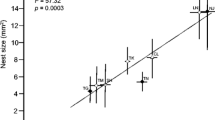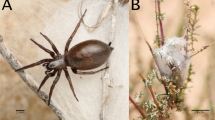Abstract
The social spider mites (Acari: Tetranychidae) of Stigmaeopsis weave dense nests on the underside of host leaves. Four species occur on the leaves of bamboo in Japan: Stigmaeopsis longus, S. celarius, S. takahashii and S. saharai. We initially reconfirmed the occurrence of distinct variation in nest size among the species. Based on the hypothesis that this variation plays a role in protecting the spider mites from predators, we looked at the behavior of the natural enemies that occur on the host plants along with members of Stigmaeopsis. We found considerable variation in the ability of nests to protect the spider-mite eggs. The smallest nests protected the eggs against three predators, whereas the largest nests protected the eggs against only one predator species. So, decreases in nest size increased egg defense. Thus we concluded that nest-size variation reflects a strategy for reducing predation.




Similar content being viewed by others
References
Alcock J (1989) Animal behavior, 4th edn. Sinauer, Boston
Chittenden AR (2002) Diversity in predator-prey interactions of plant inhabiting mites (Acari: Tetranychidae, Phytoseiidae, Stigmaeidae). PhD Thesis, Hokkaido University
Crespi BJ (1992) Eusociality in Australian gall thrips. Nature 359:724–726
Crespi BJ (1994) Three conditions for the evolution of eusociality: are they sufficient? Insectes Soc 41:395–400
Crespi BJ, Mound LA (1997) Ecology and evolution of social behavior among Australian gall thrips and their allies. In: Choe JC, Crespi BJ (eds) The evolution of social behavior in insects and arachnids. Cambridge University Press, Cambridge, pp 166–180
Dixon AFG (1973) Biology of aphids. Arnold, London
Evans DL, Schmidt JO (eds) (1990) Insect defenses: adaptive mechanisms and strategies of prey and predators. State University of New York Press, Albany, New York
Foster WA, Northcott PA (1994) Galling and the evolution of social behaviour in aphids. In: Williams MAJ (ed) Plant galls. Clarendon, Oxford, pp 161–182
Hamilton WD (1971) Geometry for the selfish herd. J Theor Biol 31:295–311
Inman AJ, Krebs J (1987) Predation and group living. Trends Ecol Evol 2:31–32
Kudo S, Ishibashi E (1996) Maternal defense of a leaf beetle is not effective against parasitoids but is against pedestrian predators. Ethology 102:560–567
Lederhouse RC (1990) Avoiding the hunt: primary defenses of lepidopteran caterpillars. In: Evans DL, Schmidt JO (eds) Insect defenses: adaptive mechanisms and strategies of prey and predators. State University of New York Press, Albany, New York, pp 175–189
Mori K (2000) Factors causing variation in social systems of spider mites, Schizotetranychus celarius species group (Acari: Tetranychidae). PhD Thesis, Hokkaido University
Mori K, Saito Y, Sakagami T (1999) Effects of nest web and female attendance on survival of young in the subsocial spider mite Schizotetranychus longus (Acari: Tetranychidae). Exp Appl Acarol 23:411–418
Price P, Fernandes GW, Waring GL (1987) Adaptive nature of insect galls. Environ Entomol 16:15–24
Pulliam RH, Caraco T (1984) Living in groups: is there an optimal group size? In: Krebs JR, Davis NB (eds) Behavioral ecology: an evolutionary approach, 2nd edn. Blackwell, Oxford, pp 122–147
Saito Y (1985) Life types of spider mites. In: Helle W, Sabelis MW (eds). Spider mites: their biology, natural enemies and control, vol 1A. Elsevier, Amsterdam, pp 253–264
Saito Y (1986a) Biparental defence in a spider mite (Acari: Tetranychidae) infesting Sasa bamboo. Behav Ecol Sociobiol 18:377–386
Saito Y (1986b) Prey kills predator: counter-attack success of a spider mite against its specific phytoseiid predator. Exp Appl Acarol 2:47–62
Saito Y (1990) Two new spider mite species of the Schizotetranychus celarius complex (Acari: Tetranychidae). Appl Entomol Zool 25:389–396
Saito Y (1995) Sociobiological aspects of spider mite life types. J Acarol Soc Jpn 4:55–67
Saito Y (1997) Sociality and kin selection in Acari. In: Choe JC, Crespi BJ (eds) The evolution of social behavior in insects and arachnids. Cambridge University Press, Cambridge, pp 443–457
Saito Y, Suzuki R (1987) Reexamination of several rearing methods for studying the life history of spider mites (Acari: Tetranychidae). Appl Entomol Zool 22:452–570
Saito Y, Takahashi K (1980) Study on variation of Schizotetranychus celarius (Banks). I. Preliminary descriptions of morphological and life type variation. Jpn J Appl Entomol Zool 24:62–70
Saito Y, Takahashi K (1982) Study on variation of Schizotetranychus celarius (Banks). II. Comparison of mode of life between two sympatric forms (Acarina: Tetranychidae). Jpn J Ecol 32:69–78
Saito Y, Mori K, Sakagami T, Lin J-Z (2004) Reinstatement of the genus Stigmaeopsis Banks, with descriptions of two new species (Acari, Tetranychidae). Ann Entomol Soc Am (in press)
Sakagami T (2002) Phylogenetic analysis of subfamily Tetranychinae (Acari: Tetranychidae) in Japan, based on 28S ribosomal DNA sequences: Does the celarius species group belong to the genus Schizotetranychus? PhD Thesis, Hokkaido University
Seger J (1991) Conflict and cooperation in social insects. In: Krebs JR, Davies NB (eds) Behavioural ecology: an evolutionary approach, 3rd edn. Blackwell, Oxford, pp 338–373
Stern DL, Foster WA (1997) The evolution of sociality in aphids: a clone’s-eye view. In: Choe JC, Crespi BJ (eds) The evolution of social behavior in insects and arachnids. Cambridge University Press, Cambridge, pp 150–165
Takahashi K (1987) Studies on morphological and ecological variations of Schizotetranychus celarius (Banks). PhD Thesis, Hokkaido University
Toyama M (1999) Adaptive advantages of maternal care and matriphagy in a foliage spider, Chiracanthium japonicum (Araneae: Clubionidae). J Ethol 17:33–39
Turner GF, Pitcher TJ (1986) Attack abatement: a model for group protection by combined avoidance and dilution. Am Nat 128:228–240
Uetz GW, Hieber CS (1994) Group size and predation risk in colonial web-building spiders: analysis of attack abatement mechanisms. Behav Ecol 5:326–333
Vulinec K (1990) Collective security: aggregation by insects as a defense. In: Evans DL, Schmidt JO (eds) Insect defenses: adaptive mechanisms and strategies of prey and predators. State University of New York Press, Albany, New York, pp 251–288
Wrona FJ, Dixon RWJ (1991) Group size and predation risk: a field analysis of encounter and dilution effect. Am Nat 137:186–201
Yanagida H, Saito Y, Mori K, Chittenden AR (2001) Egg-depositing behavior as a predator avoidance tactic of Yezonychus sapporensis Ehara (Acari, Tetranychidae). J Ethol 19:63–66
Acknowledgements
We thank Drs. Y. Watanuki, E. Hasegawa, T. Nagata, T. Gotoh, T. Sakagami, and A.R. Chittenden and Ms. Y. Sato for valuable suggestions. This study was partly supported by Grant-in-Aid for Scientific Research (B), no. 13440227 from the Japan Society for the Promotion of Science. Research activities were conducted in compliance with the current laws of Japan.
Author information
Authors and Affiliations
Corresponding author
Additional information
Communicated by D. Gwynne
Rights and permissions
About this article
Cite this article
Mori, K., Saito, Y. Nest-size variation reflecting anti-predator strategies in social spider mites of Stigmaeopsis (Acari: Tetranychidae). Behav Ecol Sociobiol 56, 201–206 (2004). https://doi.org/10.1007/s00265-004-0776-7
Received:
Revised:
Accepted:
Published:
Issue Date:
DOI: https://doi.org/10.1007/s00265-004-0776-7




